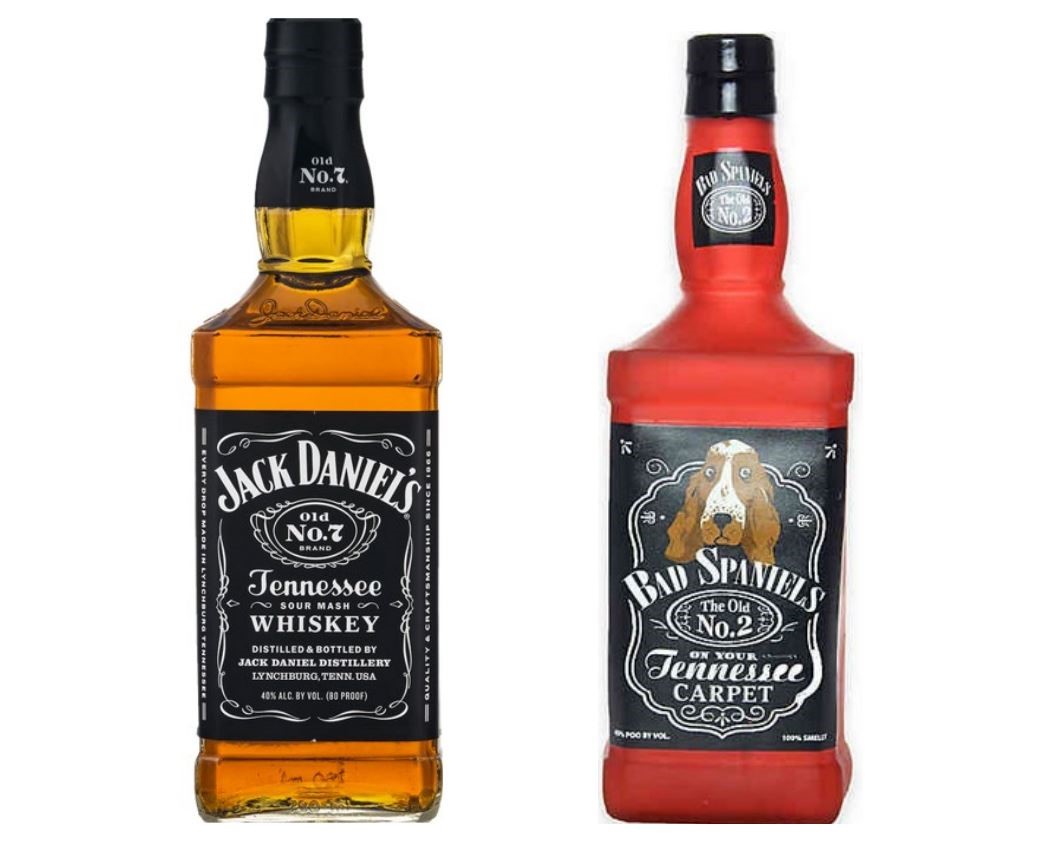Supreme Court Overrules the Ninth Circuit’s Expansion of the Rogers Test, Gives Jack Daniel’s Second Chance to Prove Trademark Infringement and Dilution
Yesterday, the Supreme Court handed down its decision in the widely-discussed case of Jack Daniel’s Properties Inc. v. VIP Products LLP. VIP Products, LLP (VIP) is well-known for making humorous squeaky dog toys that resemble well-known alcoholic beverages. Renditions include Dos Perros (Dos Equis), Smella Arpaw (Stella Artois), Doggie Walker (Johnie Walker), and the dog toy at issue, Bad Spaniels (Jack Daniel’s). The Bad Spaniels chew toy resembles the distinctive Jack Daniel’s Tennessee Whiskey square bottle, down to the black and white label with the stylized filigree. In place of “Old No. 7 Tennessee Sour Mash Whiskey,” the words “The Old No.2 on your Tennessee Carpet” appear.

Photo: Bloomberg, “‘Bad Spaniels’ Dog Toy Gets Supreme Court Review as Jack Daniel’s Claims Infringement” (Nov. 21, 2022)
Not thrilled about the use of its famous trade dress alongside a reference to excrement, Jack Daniel’s Properties Inc. (Jack Daniel’s) sent a cease and desist letter to VIP, demanding that VIP stop all sales of the toy. VIP responded by filing suit, seeking a declaratory judgment that the Bad Spaniels toy neither infringed on nor diluted Jack Daniel’s trademarks or trade dress.
The Issues
There are two main issues that the Supreme Court considers in its opinion: (1) Infringement, and whether the Rogers test applies when the subject mark is source-identifying; and (2) Dilution, and whether the parodic or non-commercial use exceptions apply when the subject mark is source-identifying. The Court declines to rule on how far the application of either doctrine should go, but it settles the question of whether each applies in the source-identifying context. When a parodic mark is used as source identifier, or in other words, as a trademark, then neither the Rogers test nor the parodic or non-commercial use exceptions apply.
Infringement
As the Supreme Court elegantly states in its opinion, the “cardinal sin” of trademark law is causing consumer confusion. Trademark law (through the Lanham Act) protects both brand owners and consumers. When one individual or entity uses a trademark that is identical, or confusingly similar, to another’s trademark on its product, consumers may be confused about the true “source” of the product.
There are a myriad of exceptions to trademark “infringement,” and one of those is use of another’s mark through artistic expression.
Enter the Rogers test. The Rogers test, on which VIP relied in the courts below to avoid liability, is a threshold test developed by the Second Circuit that was designed to protect First Amendment interests (i.e., free speech) in the trademark context. When “expressive works” are involved, Rogers requires dismissal of an infringement claim at the outset unless the complainant can show either (1) that the challenged use of a mark has no artistic relevance to the underlying work, or (2) that it explicitly misleads as to the source or the content of the work.
As the Supreme Court noted, the Bad Spaniels mark is prominently displayed across the front of the dog toy packaging in addition to on the toy itself. On the back of the packing, the Bad Spaniels logo also appears. VIP argues in its complaint that it both “owns” and “uses” the Bad Spaniels trademark and trade dress, and although it has not filed a trademark application to register the mark, it does have registrations for several other parodic dog toy names. The Bad Spaniels mark acts as a source-identifier, and consumers purchasing the toys will know that VIP is the source of the Bad Spaniels products. Accordingly, the Supreme Court held that application of the Rogers test is not appropriate in this context.
The Supreme Court points out in its opinion that courts have always applied the doctrine in this way—Rogers is applied in cases where the mark is used in an expressive way, and it is not used in cases where the mark is used in a source-identifying way. The Court now clarifies the rule: Rogers has always been a “cabined doctrine” that applies only to cases involving non-source identifying uses. Therefore, the lower court must hear the case and decide its ruling based on whether there is a likelihood of consumer confusion between Jack Daniel’s and Bad Spaniels rather than dismissing at the outset.
Dilution
The Supreme Court considered the dilution issue and reached a similar result. Dilution is a claim only available to owners of “famous” marks—that is, those marks that are widely recognized (e.g., Jack Daniel’s, Barbie, Apple, Nike). There are two types of dilution—blurring, which does not apply here, and tarnishment. Tarnishment occurs when a famous mark is used alongside something derogatory or perhaps off-putting, like excrement, and thus “tarnishes” the goodwill of the trademark holder. In this case, Jack Daniel’s argued that the Bad Spaniels dog toy linked its whiskey to “less savory substances”—the allusion to “Number 2” is a less than flattering association for an ingestible product.
The Lanham Act includes exclusions from dilution liability for both “non-commercial use” and “fair use,” which specifically permits the “parodying, criticizing, or commenting upon” a famous mark. In other words, the First Amendment allows entities and individuals to poke fun at even the most successful of brands. There is one crucial caveat here—again, neither of these exclusions apply when the mark is being used as a source-identifier. In this instance, the Supreme Court held that Bad Spaniels cannot rely on these exclusions from dilution liability just because its dog toys are humorous.
Moving Forward
Effectively, the Supreme Court’s ruling can be summarized as follows: VIP does not have a get-out-of-jail-free card because it thinks its toy is humorous. The source-identifying use of the Bad Spaniels mark means that neither the Rogers test nor the dilution exceptions applies, so a dismissal at the outset under those doctrines was improper.
The Court has remanded the case back to the lower courts to determine whether VIP’s Bad Spaniels toy infringes or dilutes Jack Daniel’s marks. The Court does note, however, both in its opinion and in a concurrence penned by Justice Sotomayor, that the mark’s parodic nature is a factor that must be carefully considered in the likelihood of confusion analysis. Per J. Kagan: “[A] parody must also create contrasts, so that its message of ridicule or pointed humor comes clear. And once that is done (if that is done), a parody is not often likely to create confusion. Self-deprecation is one thing; self-mockery far less ordinary.”
We will continue to follow this case as the courts re-consider the issue of consumer confusion in a parodic context.
Please contact your Vorys attorney if you have any questions about the impact of this ruling on your trademark portfolio or your branding or litigation strategy.


